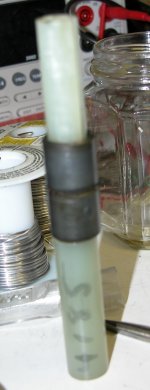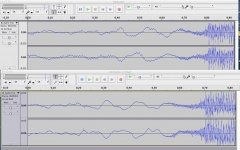Schopper AG has a new US supplier for Thorens parts
I contacted Christine at Schopper AG the other day, inquiring about some parts. She got back to me, quite quickly I might add, telling me that they had arranged for a New York firm to provide parts in the USA. In fact, in ensuing e-mails she said that due to the contract Shopper had with the firm, Schopper would no longer be able to directly fulfill order requests from the USA.
The new USA Schopper distributor is Audioarts.co (not .com). The contact's name is Gideon. Gideon also responded to e-mail quickly and will be getting me USA parts pricing this afternoon. The Audioarts.co web site shows they are offering a pretty wide range of audio equipment, but I did not see any pricing there.
Below is his contact e-mail.
gideon@audioarts.co
I contacted Christine at Schopper AG the other day, inquiring about some parts. She got back to me, quite quickly I might add, telling me that they had arranged for a New York firm to provide parts in the USA. In fact, in ensuing e-mails she said that due to the contract Shopper had with the firm, Schopper would no longer be able to directly fulfill order requests from the USA.
The new USA Schopper distributor is Audioarts.co (not .com). The contact's name is Gideon. Gideon also responded to e-mail quickly and will be getting me USA parts pricing this afternoon. The Audioarts.co web site shows they are offering a pretty wide range of audio equipment, but I did not see any pricing there.
Below is his contact e-mail.
gideon@audioarts.co
Early TD124 Refurb
Doing a minor overhaul for a friend on a very early TD-124, this one certainly dates from around 1957, serial number well below 2000..
The bearing and spindle are quite different from later units as you will see in the pictures.
I've rebuilt the main bearing which had swollen, disintegrating nylon bushings and a bakelite thrust plate that it appears someone made from hand.
The end cap appears to be original but is not like the later coined end cap so many people including myself thought was bent. (I've seen enough to now know better)
I believe this bearing originally would not have had a separate thrust plate but having fitted sintered bronze bushings I decided to install a new nylatron thrust plate as well.
The bushings were oil impregnated in hot 20wt oil prior to installation. Despite my efforts to keep everything clean there is lint and other debris from the overhaul so I will flush the bearing with oil prior to installation.
Next I will tear down and lub the motor, this one is on a tight budget so bearings will be retained as will the felts. This motor actually runs ok.
The top platter unfortunately is awol.. This machine will be used exclusively to play 78s.
Doing a minor overhaul for a friend on a very early TD-124, this one certainly dates from around 1957, serial number well below 2000..
The bearing and spindle are quite different from later units as you will see in the pictures.
I've rebuilt the main bearing which had swollen, disintegrating nylon bushings and a bakelite thrust plate that it appears someone made from hand.
The end cap appears to be original but is not like the later coined end cap so many people including myself thought was bent. (I've seen enough to now know better)
I believe this bearing originally would not have had a separate thrust plate but having fitted sintered bronze bushings I decided to install a new nylatron thrust plate as well.
The bushings were oil impregnated in hot 20wt oil prior to installation. Despite my efforts to keep everything clean there is lint and other debris from the overhaul so I will flush the bearing with oil prior to installation.
Next I will tear down and lub the motor, this one is on a tight budget so bearings will be retained as will the felts. This motor actually runs ok.
The top platter unfortunately is awol.. This machine will be used exclusively to play 78s.
Attachments
-
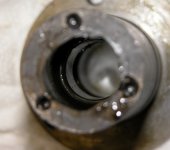 bearing_open2.jpg118.2 KB · Views: 374
bearing_open2.jpg118.2 KB · Views: 374 -
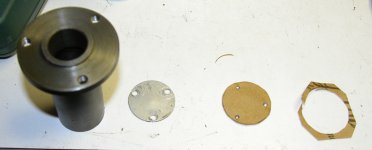 housing-gasket-cover.jpg417.7 KB · Views: 359
housing-gasket-cover.jpg417.7 KB · Views: 359 -
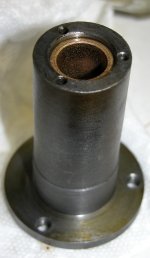 new-bushings.jpg218.2 KB · Views: 357
new-bushings.jpg218.2 KB · Views: 357 -
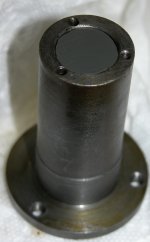 thrust-plate-added.jpg193 KB · Views: 344
thrust-plate-added.jpg193 KB · Views: 344 -
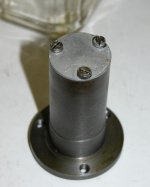 all_together2.jpg170.9 KB · Views: 343
all_together2.jpg170.9 KB · Views: 343 -
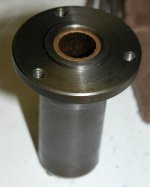 all_together.jpg178.7 KB · Views: 119
all_together.jpg178.7 KB · Views: 119 -
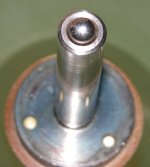 early_spindle.jpg174.1 KB · Views: 122
early_spindle.jpg174.1 KB · Views: 122 -
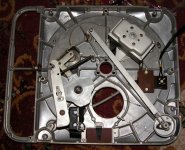 rear view ClkJ 124.jpg245.9 KB · Views: 138
rear view ClkJ 124.jpg245.9 KB · Views: 138 -
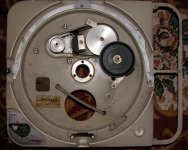 top view clkj 124.jpg228.6 KB · Views: 133
top view clkj 124.jpg228.6 KB · Views: 133
...............................................
The top platter unfortunately is awol.. This machine will be used exclusively to play 78s.
20 years ago several of us who used 124 TTs in the UK ran them without the top plate. It was our experience that - with a suitable mat - they sounded better without that top platter plate. (It's main purpose was for DJ use, not sonic quality). I used a French (Spectre?) mat made of a very soft rubber with a thin 'tacky' skin which gripped the disc. Also used a substantial brass/bronze record puck/clamp. The difference between this set-up and factory set-up was a substantial improvement in overall sound quality, especially with regard to giving more space around individual instruments. However a solid, fine grain, graphite (NOT graphite compound.) mat of about 1/4" - 1/2" thickness will make the TT a totally different beast with improvements in all areas. ART (the old Italian company, not the UK company) used to sell such a mat.
The bushings were oil impregnated in hot 20wt oil prior to installation. Despite my efforts to keep everything clean there is lint and other debris from the overhaul so I will flush the bearing with oil prior to installation.
Next I will tear down and lub the motor, this one is on a tight budget so bearings will be retained as will the felts. This motor actually runs ok.
After running a full LP on my project TD 124 and being pretty impressed with the sound, it's time to do the full drive rebuild, so after reading through many of your postings, I've got a few questions for you.
What specifically are the oils you settled on for the main bearing well and the motor bushings?
I got the impression that at least for a time you were having trouble getting a rebuilt motor to settle down. Some days it worked well, other days notsomuch. If I'm correct on that, did you ever determine the cause?
With respect to the drive belt, I gather you purchased a replacement. Several postings suggest all replacements, regardless of source are too tight initially and I get the impression the solution has been to stretch them a bit. Where did you finally source your belt from and what's your take on the "too tight" theory? If you did stretch it, how did you accomplish that and how much did you stretch it?
Hi missouricatman,
I use Three-In-One 20wt electric motor oil - not to be confused with regular Three-In-One, you can identify this as the bottle has a picture of an electric motor on the front. I've posted pictures of the specific type I use. I use this in the main bearing, motor bearings, intermediate pulley and idler pulley bearings as well.
My motor problem was quickly resolved - it turns out that I did not sufficiently impregnate the bearings and was too sparing with the oil when wetting the felts.
I've had no further problems in over a year of nearly daily operation.
Soaking the new motor bearings in hot 20wt oil and allowing them to fully cool is important, but it is equally important to soak the felt so that it is not attempting to draw the oil out of the bearing and is wet enough to supply lubrication to the bearings.
I've found the Schopper to be the best belt overall, with some run in it is extremely quiet, and unlike the Thakker belt leaves no residue on the pulley surfaces. The belts sold on eBay by a fellow in FLA (Hollywood IIRC) have turned out to quite decent as well, but not as quiet as the Schopper with substantial running time. The belts seem to stretch a little with use - I have two original belts in good condition and the Schopper will stretch to the same length as the originals in relatively short order. The Thakker stretch a lot as well and ran quietly until the goo built up on the pulleys - this became a major problem in short order with this belt. None of the modern belts except possibly the Schopper run as quietly as a good original.
I use Three-In-One 20wt electric motor oil - not to be confused with regular Three-In-One, you can identify this as the bottle has a picture of an electric motor on the front. I've posted pictures of the specific type I use. I use this in the main bearing, motor bearings, intermediate pulley and idler pulley bearings as well.
My motor problem was quickly resolved - it turns out that I did not sufficiently impregnate the bearings and was too sparing with the oil when wetting the felts.
I've had no further problems in over a year of nearly daily operation.
Soaking the new motor bearings in hot 20wt oil and allowing them to fully cool is important, but it is equally important to soak the felt so that it is not attempting to draw the oil out of the bearing and is wet enough to supply lubrication to the bearings.
I've found the Schopper to be the best belt overall, with some run in it is extremely quiet, and unlike the Thakker belt leaves no residue on the pulley surfaces. The belts sold on eBay by a fellow in FLA (Hollywood IIRC) have turned out to quite decent as well, but not as quiet as the Schopper with substantial running time. The belts seem to stretch a little with use - I have two original belts in good condition and the Schopper will stretch to the same length as the originals in relatively short order. The Thakker stretch a lot as well and ran quietly until the goo built up on the pulleys - this became a major problem in short order with this belt. None of the modern belts except possibly the Schopper run as quietly as a good original.
<snip>
However a solid, fine grain, graphite (NOT graphite compound.) mat of about 1/4" - 1/2" thickness will make the TT a totally different beast with improvements in all areas. ART (the old Italian company, not the UK company) used to sell such a mat.
Boston Audio sells a graphite mat that is reputedly pretty good. The older of my two tables is also missing the top platter, this unit has the zamac platter (zingy/ringy) that was originally on my TD124/II, and on top of that is a glass platter - I usually play records directly on the glass. Sounds quite good. I also have a Herbies Audio mat that I sometimes place on the glass, but I think I prefer it without. The glass platter which runs directly atop the main platter without the dots seems to damp out the ring in the zamac.
The TD124/II has the upper platter with geltec dots on an oem cast iron platter. The upper platter has a Merrill-Scillia mat on it which is a combination of lead, rubber and cork - it provides quite a lot of damping, and works well with my various SPUs (Meister Silver GM and Classic GM E II) which are quite lively on their own, and relatively unforgiving about things getting through from the drive train and reflected energy during playback. Imaging, depth, dynamics and overall resolution are the best I have had so far.
Hi missouricatman,
I use Three-In-One 20wt electric motor oil - not to be confused with regular Three-In-One, you can identify this as the bottle has a picture of an electric motor on the front. I've posted pictures of the specific type I use. I use this in the main bearing, motor bearings, intermediate pulley and idler pulley bearings as well.
My motor problem was quickly resolved - it turns out that I did not sufficiently impregnate the bearings and was too sparing with the oil when wetting the felts.
I've had no further problems in over a year of nearly daily operation.
Soaking the new motor bearings in hot 20wt oil and allowing them to fully cool is important, but it is equally important to soak the felt so that it is not attempting to draw the oil out of the bearing and is wet enough to supply lubrication to the bearings.
I've found the Schopper to be the best belt overall, with some run in it is extremely quiet, and unlike the Thakker belt leaves no residue on the pulley surfaces. The belts sold on eBay by a fellow in FLA (Hollywood IIRC) have turned out to quite decent as well, but not as quiet as the Schopper with substantial running time.
Thanks kevinkr. Ok, I know the oil you're talking about. It isn't used in cruise missiles (inside joke, but given you've been dealing with suppliers for awhile, you probably get it), but it's a good all-around electric motor oil.
Did you source the motor bearings from Schopper too? And as you didn't mention anything regarding the Schopper belt being too tight initially, I gather that wasn't your experience? Thanks for all the info.
Hi missouricatman,
The bearing kit was purchased from jec965 on eBay, I've also used ones from analog depot when they were still available. As long as you make sure to impregnate them properly there should be no problem.
Yeah, I stopped obsessing over the belt tension issue as they loosen up pretty quickly in use, they will stretch something like a half inch or more with use.
I can imagine this is a much bigger issue for Europeans running these tables with the larger diameter 50Hz pulley than it is for those of us in the 60Hz world.
I have never been able to conclusively determine that there were different belts for 50Hz and 60hz installations, as has been alleged, but there are definitely two different belt part numbers over time, but I have never seen the earlier PN. Original Thorens belts from the 1960s are both more pliant and somewhat thinner than any modern belt I have encountered. (More IMHO than would be accounted for by stretch) See my measurements further back in the thread if you are curious.
The bearing kit was purchased from jec965 on eBay, I've also used ones from analog depot when they were still available. As long as you make sure to impregnate them properly there should be no problem.
Yeah, I stopped obsessing over the belt tension issue as they loosen up pretty quickly in use, they will stretch something like a half inch or more with use.
I can imagine this is a much bigger issue for Europeans running these tables with the larger diameter 50Hz pulley than it is for those of us in the 60Hz world.
I have never been able to conclusively determine that there were different belts for 50Hz and 60hz installations, as has been alleged, but there are definitely two different belt part numbers over time, but I have never seen the earlier PN. Original Thorens belts from the 1960s are both more pliant and somewhat thinner than any modern belt I have encountered. (More IMHO than would be accounted for by stretch) See my measurements further back in the thread if you are curious.
Hi missouricatman,
The bearing kit was purchased from jec965 on eBay, I've also used ones from analog depot when they were still available. As long as you make sure to impregnate them properly there should be no problem.
Yeah, I stopped obsessing over the belt tension issue as they loosen up pretty quickly in use, they will stretch something like a half inch or more with use.
I can imagine this is a much bigger issue for Europeans running these tables with the larger diameter 50Hz pulley than it is for those of us in the 60Hz world.
I have never been able to conclusively determine that there were different belts for 50Hz and 60hz installations, as has been alleged, but there are definitely two different belt part numbers over time, but I have never seen the earlier PN. Original Thorens belts from the 1960s are both more pliant and somewhat thinner than any modern belt I have encountered. (More IMHO than would be accounted for by stretch) See my measurements further back in the thread if you are curious.
Hi Kevinkr. Thanks for the info. Right now looks like the bearing that needs replacing first is the one for the stepped pulley. Until this morning, I hadn't pulled and cleaned the stepped pulley or the idler wheel, nor had I oiled the top motor bearing. With that done, the turntable comes up to speed in about one rev., but my cleaning introduced some noise from the stepped pulley. Inspection shows it to be wobbling just a hair. Until I get a new bearing, I'm thinking that instead of 20wt, a silicone grease may be the ticket. I suspect all that dark matter I swabbed out was actually helping to keep it quiet, since it was likely tighter before the cleaning.
As for spin-down, I'd say at 33 1/3 it's taking about 45 seconds to come to a stop. The main bearing's still oiled with Mobil 1 10-30 wt.
Other notes on overall condition. I've examined what I assume is the original belt by stretching it slightly and looking for any cracks. Looks just fine to me, so I just reversed it. I may order a replacement, but it seems to run just fine, so don't see a point just yet. The motor bushings may benefit from replacement, but if it's making any noise, it would take a stethoscope to tell. As for the motor mounts, they're intact and pliant, but there was enough rubber debris scattered about to suggest they should get swapped out too.
By the way, I've been pulling spectrograms using Audacity if anyone is interested. I'm sampling output with the tonearm at rest, of the run-in, about 3:00 minutes in, and the run-out. I've been capturing the waveform at maximum magnification and putting that next to the spectrogram.
I've been using an Ortofon I had installed when I bought a Technics SL-D2 new back in the 80s and while I doubt it's the best match, I'm pretty pleased with it. The stylus on that one is an OEM replacement with probably 20 hours on it at most.
Last edited:
Hi missouricatman,
There is an eBay seller based in Spain who sells replacement bearings for the later variant of the intermediate pulley used in the TD-124/II. These have only recently become available and he is the sole source I am aware of, probably a good idea to get some now. Your table must have a good many hours of use on it as I have never seen one with significant wear in the intermediate pulley bearing.
Yeah it's a good idea to replace the motor mounting bushings. I'm running geltec bushings from jec965 in my TD-124/II and they do seem to make a difference. I just acquired a set of natural rubber bushings for my other TD-124 and will be installing them shortly.
A spectrograph of the noise spectrum of your table should be of interest..
There is an eBay seller based in Spain who sells replacement bearings for the later variant of the intermediate pulley used in the TD-124/II. These have only recently become available and he is the sole source I am aware of, probably a good idea to get some now. Your table must have a good many hours of use on it as I have never seen one with significant wear in the intermediate pulley bearing.
Yeah it's a good idea to replace the motor mounting bushings. I'm running geltec bushings from jec965 in my TD-124/II and they do seem to make a difference. I just acquired a set of natural rubber bushings for my other TD-124 and will be installing them shortly.
A spectrograph of the noise spectrum of your table should be of interest..
Hi missouricatman,
There is an eBay seller based in Spain who sells replacement bearings for the later variant of the intermediate pulley used in the TD-124/II. These have only recently become available and he is the sole source I am aware of, probably a good idea to get some now. Your table must have a good many hours of use on it as I have never seen one with significant wear in the intermediate pulley bearing.
Yeah it's a good idea to replace the motor mounting bushings. I'm running geltec bushings from jec965 in my TD-124/II and they do seem to make a difference. I just acquired a set of natural rubber bushings for my other TD-124 and will be installing them shortly.
A spectrograph of the noise spectrum of your table should be of interest..
Hi Kevinkr,
When I was cleaning the stepped pulley well, I flipped what I presume is a teflon disk that was in the bottom. At the time, I thought it a good thing to do, because I could see a depression in the middle. However, for all I know, I swapped a concave surface for a convex one, which obviously would not be a good thing! In the morning I'll put it back the way it was and see if that settles the thing down. Still, I don't see how that could result in a shimmy unless there is some slop in the bushing, so I'll see if I can track down the ebay seller you mentioned.
By the way, a little insight as to how you managed to press old bushings out and new ones in might be helpful as I move on to this next stage.
There is no doubt though that as changes are made, it takes some time for things to settle in. I was seeing some noise at max magnification in Audacity that after recording three sides, seems to have disappeared.
I'll pull some more spectrograms in the morning and will post them.
Hi missouricatman,
I've never pressed out the bearings for the intermediate pulley, but I would imagine that you would remove the thrust screw and nut and using a custom machined piece of drill rod press them out. IMO you would machine the drill rod so that it has a step on it and the narrowed diameter would be enough to go through 2 X the length of the existing bushing so that it captures the second one on the way out. Press out from the bottom since that end is threaded..
I've attached a picture of the tool I use to replace the main bushings. There are a pair of nylon bushings still on it from the main bearing I posted about in a previous post.. This tool was turned from G10 and has a step. It is designed to allow bearings to be pushed out or extracted as required - the longer part is split and there is a wedge that can be inserted to force the tool to grip the bearing if this proves to be necessary - it has not been necessary so far.
I've never pressed out the bearings for the intermediate pulley, but I would imagine that you would remove the thrust screw and nut and using a custom machined piece of drill rod press them out. IMO you would machine the drill rod so that it has a step on it and the narrowed diameter would be enough to go through 2 X the length of the existing bushing so that it captures the second one on the way out. Press out from the bottom since that end is threaded..
I've attached a picture of the tool I use to replace the main bushings. There are a pair of nylon bushings still on it from the main bearing I posted about in a previous post.. This tool was turned from G10 and has a step. It is designed to allow bearings to be pushed out or extracted as required - the longer part is split and there is a wedge that can be inserted to force the tool to grip the bearing if this proves to be necessary - it has not been necessary so far.
Attachments
Thorens TD 124 MK II vs Dual 1219
OK, this is hardly a fair comparison, given I've already rebuilt the Dual 1219, plus it's running a Shure V15 MKIII with the JICO SAS stylus, but it does give some idea of why the Thorens needs all the bushings replaced. The attached image shows at maximum magnification of amplitude, a snippet of the lead in on a disk I'd first recorded on the Thorens, then on the Dual. To keep things honest, the rumble filter was off for this test run. The Thorens is on top.
OK, this is hardly a fair comparison, given I've already rebuilt the Dual 1219, plus it's running a Shure V15 MKIII with the JICO SAS stylus, but it does give some idea of why the Thorens needs all the bushings replaced. The attached image shows at maximum magnification of amplitude, a snippet of the lead in on a disk I'd first recorded on the Thorens, then on the Dual. To keep things honest, the rumble filter was off for this test run. The Thorens is on top.
Attachments
I'd start with the motor overhaul and bushings, and give the intermediate pulley and motor pulley running surfaces a good cleaning with a light pass with scotchbrite followed by 1000 grit sand paper for a wet polish. It may well be that the intermediate pulley bushings need to be replaced, but yours would be the first I have heard of that required this - but it is quite possible, and replacing them can't hurt. (If you can see wobble either the shaft is slightly bent or the bearings are really bad) My TD-124/II came to me from the original owner and had very few hours of use - a couple of hundred at most.
The 124 also benefits from being directly coupled to a heavy, lossy plinth. In terms of rumble if everything is working correctly about 1 in 10 records will have a residual rumble level close to that of the TD-124/II and most will be much worse. Prior to this set up I never had anything this quiet. (Of course I did not have the resolution either, Schick and Meister Silver are pretty hard to beat IMVLE.. )
The 124 also benefits from being directly coupled to a heavy, lossy plinth. In terms of rumble if everything is working correctly about 1 in 10 records will have a residual rumble level close to that of the TD-124/II and most will be much worse. Prior to this set up I never had anything this quiet. (Of course I did not have the resolution either, Schick and Meister Silver are pretty hard to beat IMVLE.. )
Morning krvinkr,
Yes, I considered that the stepped pulley shaft may have gotten bent, that the bearings aren't the issue. Next time I get into it, I'll be trying to isolate the cause. I'm pretty sure whichever is the problem, it's also the reason I'm getting a little noise from the pulley. It really sounds as though at some point the pulley is just lightly scraping something as it rotates. The noise wavers with the rotation. Now if it's bent, coming up with a safe way to true it up might be a bit of a challenge.
Since each drive train element can impact others, I also suspect that whatever is making the stepped pulley wobble is probably also the reason I see a small height deviation in the idler wheel. It travels up and down the stepped pulley a hair.
While I may take on replacing bushings in steps, there are enough that need to be done that I may track down a machine shop here in Kansas City. As you pointed out, creating a tool to press the old bushings out requires milling a rod, unless I managed to come across the right tool ready to go. If it involves machining, I won't be able to do that on my own, so might as well try to find a place all set up to press bushings out properly. If I had all the measurements, getting custom bushings milled would probably be possible too, although whether I could get it done more cheaply than I could buy them is questionable. My guess is the type of machine shop I need to work with rebuilds industrial motors and we've got several of those around here.
As for polishing various spindles, I'm pretty well set up. I think the finest grit I've got is 3000 wet or dry.
I didn't quite get your comment on rumble on the TD 124/II. Did you mean to say that all things being equal, the Dual 1219 should have more rumble than the TD 124/II once its rebuilt?
Yes, I considered that the stepped pulley shaft may have gotten bent, that the bearings aren't the issue. Next time I get into it, I'll be trying to isolate the cause. I'm pretty sure whichever is the problem, it's also the reason I'm getting a little noise from the pulley. It really sounds as though at some point the pulley is just lightly scraping something as it rotates. The noise wavers with the rotation. Now if it's bent, coming up with a safe way to true it up might be a bit of a challenge.
Since each drive train element can impact others, I also suspect that whatever is making the stepped pulley wobble is probably also the reason I see a small height deviation in the idler wheel. It travels up and down the stepped pulley a hair.
While I may take on replacing bushings in steps, there are enough that need to be done that I may track down a machine shop here in Kansas City. As you pointed out, creating a tool to press the old bushings out requires milling a rod, unless I managed to come across the right tool ready to go. If it involves machining, I won't be able to do that on my own, so might as well try to find a place all set up to press bushings out properly. If I had all the measurements, getting custom bushings milled would probably be possible too, although whether I could get it done more cheaply than I could buy them is questionable. My guess is the type of machine shop I need to work with rebuilds industrial motors and we've got several of those around here.
As for polishing various spindles, I'm pretty well set up. I think the finest grit I've got is 3000 wet or dry.
I didn't quite get your comment on rumble on the TD 124/II. Did you mean to say that all things being equal, the Dual 1219 should have more rumble than the TD 124/II once its rebuilt?
Hi missouricatman,
Hopefully it isn't a case of bent spindle on the intermediate pulley.. One of the unfortunate issues with this design is that the intermediate pulley will ring slightly if there is anything on the running surfaces, a good clean and some talc on the belt will do wonders. The eddy current brake generates a significant amount of noise as well, but you should not hear any scraping sounds.
Something to bear in mind - if you are hearing scraping it is likely that the intermediate pulley height is no longer correct due to wear in the thrust pad at the bottom of the bearing well - you can replace this part if necessary, but in either case a slight adjustment of the thrust bearing height should be performed.
Next check the idler, many of them may wobble a few thousandths in normal operation and as long as it does not hit the next step down on the pulley and is not extreme it does not seem to cause a significant performance issue.
Verify that the idler runs near the middle of the step on several speeds, and note that this height can be adjusted - there is a lock screw on the speed cam follower that sets the height, shims can also be used. Normally a very small tweak is all that is needed. I've only had to do this on one table that like yours had an issue with the intermediate pulley due to a missing thrust pad. (Had to make one)
Mirko sells a very nice replacement idler wheel - I have one as a spare against the day I need to replace one of mine, but I suspect at some point I may change to it as I suspect it may be even quieter than the really nice vintage one I am currently running.
I think your best course of action is to find someone to make the tools and do the bushing replacements yourself, it's not too hard, and several on line machine shops can probably also make the required tools. The Spanish made bushings sold on eBay are extremely inexpensive even with shipping (which is very quick from Spain) so I can't imagine you'll find them cheaper in the quantities you need.
I can't say for sure whether or not the TD-124/II has less rumble than a Dual 1219, but given their respective locations in the food chain it should be the case.. What I can say is that the TD-124/II in proper working order has much less rumble than most cutters used to cut records. I do have a number of records that were cut on heavily tweaked and upgraded cutters with rather low rumble, and I hear no rumble at all on these recordings. (My Onken style bass modules start to nose dive around 35Hz) It is an extremely quiet machine - mine however had very little use in its original life - I'm making up for that now at the rate of about 15 - 20 hrs a week.
Hopefully it isn't a case of bent spindle on the intermediate pulley.. One of the unfortunate issues with this design is that the intermediate pulley will ring slightly if there is anything on the running surfaces, a good clean and some talc on the belt will do wonders. The eddy current brake generates a significant amount of noise as well, but you should not hear any scraping sounds.
Something to bear in mind - if you are hearing scraping it is likely that the intermediate pulley height is no longer correct due to wear in the thrust pad at the bottom of the bearing well - you can replace this part if necessary, but in either case a slight adjustment of the thrust bearing height should be performed.
Next check the idler, many of them may wobble a few thousandths in normal operation and as long as it does not hit the next step down on the pulley and is not extreme it does not seem to cause a significant performance issue.
Verify that the idler runs near the middle of the step on several speeds, and note that this height can be adjusted - there is a lock screw on the speed cam follower that sets the height, shims can also be used. Normally a very small tweak is all that is needed. I've only had to do this on one table that like yours had an issue with the intermediate pulley due to a missing thrust pad. (Had to make one)
Mirko sells a very nice replacement idler wheel - I have one as a spare against the day I need to replace one of mine, but I suspect at some point I may change to it as I suspect it may be even quieter than the really nice vintage one I am currently running.
I think your best course of action is to find someone to make the tools and do the bushing replacements yourself, it's not too hard, and several on line machine shops can probably also make the required tools. The Spanish made bushings sold on eBay are extremely inexpensive even with shipping (which is very quick from Spain) so I can't imagine you'll find them cheaper in the quantities you need.
I can't say for sure whether or not the TD-124/II has less rumble than a Dual 1219, but given their respective locations in the food chain it should be the case.. What I can say is that the TD-124/II in proper working order has much less rumble than most cutters used to cut records. I do have a number of records that were cut on heavily tweaked and upgraded cutters with rather low rumble, and I hear no rumble at all on these recordings. (My Onken style bass modules start to nose dive around 35Hz) It is an extremely quiet machine - mine however had very little use in its original life - I'm making up for that now at the rate of about 15 - 20 hrs a week.
Hi kevinkr,
When I was working on the Thorens this weekend, I did tweak the height adjustment screw for the stepped pulley, in part to be certain I was spot-on with the idler wheel on all speeds, but more to investigate the scraping sound and mild shimmy. I did it while the turntable was running (re-oiled afterward), so I could hear in real time any changes while raising and lowering the stepped pulley. While I did get it quieted down a fair amount, I'm pretty sure that was the result of flipping the teflon thrust pad back so the base of the stepped pulley spindle was back in the tiny impression I assumed was a wear spot.
In any event, as a result of making that adjustment, I know it's not hitting the top of the bushing, nor is the bottom of the idler wheel hitting the top of the next step. What I failed to do, however was to simply check at idle to see if I had any play in the bushing.
As for the idler wheel, I haven't really checked that for play either. You mentioned normal operation may allow for a few thousandths of an inch. I'd say I've got a tad more than that going on. It's not walking a lot, but it is walking more than I suspect it should, although I'm basing that on how the Dual 1249 idler wheel behaves with its platter off. The Thorens idler wheel is larger, of course, so anything that's transmitted to to the outer edge will be more apparent, but doubt it's just that.
I don't think I mentioned what I'm using downstream of the turntables. I picked up a Sansui AU 719 for $99 at a local thrift store. I'm sure there are better amps, but outside of studios I did some work with back in the 70's, I sure haven't had access to them. I've yet to have it gone through (setting bias is within my knowledge base, but past that I'd be gambling), simply because I'm so happy with the upgrade I don't much like the idea of being without it.
When I was working on the Thorens this weekend, I did tweak the height adjustment screw for the stepped pulley, in part to be certain I was spot-on with the idler wheel on all speeds, but more to investigate the scraping sound and mild shimmy. I did it while the turntable was running (re-oiled afterward), so I could hear in real time any changes while raising and lowering the stepped pulley. While I did get it quieted down a fair amount, I'm pretty sure that was the result of flipping the teflon thrust pad back so the base of the stepped pulley spindle was back in the tiny impression I assumed was a wear spot.
In any event, as a result of making that adjustment, I know it's not hitting the top of the bushing, nor is the bottom of the idler wheel hitting the top of the next step. What I failed to do, however was to simply check at idle to see if I had any play in the bushing.
As for the idler wheel, I haven't really checked that for play either. You mentioned normal operation may allow for a few thousandths of an inch. I'd say I've got a tad more than that going on. It's not walking a lot, but it is walking more than I suspect it should, although I'm basing that on how the Dual 1249 idler wheel behaves with its platter off. The Thorens idler wheel is larger, of course, so anything that's transmitted to to the outer edge will be more apparent, but doubt it's just that.
I don't think I mentioned what I'm using downstream of the turntables. I picked up a Sansui AU 719 for $99 at a local thrift store. I'm sure there are better amps, but outside of studios I did some work with back in the 70's, I sure haven't had access to them. I've yet to have it gone through (setting bias is within my knowledge base, but past that I'd be gambling), simply because I'm so happy with the upgrade I don't much like the idea of being without it.
Early TD124 Refurb Part II
Rebuilt the motor today and happy to report the table now runs on speed and has been doing so for several hours now. The table after reassembly just refused to run at full speed, it was just slightly slow no matter what I did - even disabling the eddy current brake didn't help. The problem was evident on all speeds - pointing to the motor.
This is a tight budget project for an acquaintance so where possible parts are being cleaned up and reused.
The last picture shows the victim apart and the rivets retaining the bearing housings have been drilled out.
The first and second picture show the original felts in soak cycle 3 of 5 in lacquer thinner, and when clean and dry. The felts looked and felt pretty good after their soak in lacquer thinner, they were pretty hard from the oil gummy oil prior to soaking. I dried them thoroughly before impregnating them with fresh oil
The third picture shows filthy oil oozing out of the bearings in my dedicated workshop oven after being heated to 300 degrees F (149 degrees C), this was followed by a quick soak in lacquer thinner. Once clean they were soaked in hot oil in the oven for 10 minutes and then allowed to cool.
The fourth picture shows the upper bearing housing sans large felt, but otherwise ready to be reinstalled.
Fifth picture is the lower housing , six with lower housing completed, and seven is the motor reassembled. Make sure the bearings are aligned properly prior to tightening things down and check for freedom of rotation and noise (powered on the bench) prior to installation if possible.
The next to last is the victim being run in. So far running on speed for a couple of hours.
Rebuilt the motor today and happy to report the table now runs on speed and has been doing so for several hours now. The table after reassembly just refused to run at full speed, it was just slightly slow no matter what I did - even disabling the eddy current brake didn't help. The problem was evident on all speeds - pointing to the motor.
This is a tight budget project for an acquaintance so where possible parts are being cleaned up and reused.
The last picture shows the victim apart and the rivets retaining the bearing housings have been drilled out.
The first and second picture show the original felts in soak cycle 3 of 5 in lacquer thinner, and when clean and dry. The felts looked and felt pretty good after their soak in lacquer thinner, they were pretty hard from the oil gummy oil prior to soaking. I dried them thoroughly before impregnating them with fresh oil
The third picture shows filthy oil oozing out of the bearings in my dedicated workshop oven after being heated to 300 degrees F (149 degrees C), this was followed by a quick soak in lacquer thinner. Once clean they were soaked in hot oil in the oven for 10 minutes and then allowed to cool.
The fourth picture shows the upper bearing housing sans large felt, but otherwise ready to be reinstalled.
Fifth picture is the lower housing , six with lower housing completed, and seven is the motor reassembled. Make sure the bearings are aligned properly prior to tightening things down and check for freedom of rotation and noise (powered on the bench) prior to installation if possible.
The next to last is the victim being run in. So far running on speed for a couple of hours.
Attachments
-
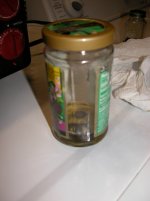 soaking_felts.jpg241.2 KB · Views: 442
soaking_felts.jpg241.2 KB · Views: 442 -
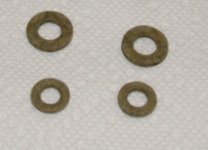 clean_felts.jpg115.6 KB · Views: 433
clean_felts.jpg115.6 KB · Views: 433 -
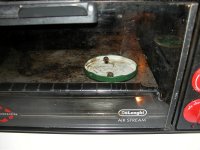 dirty_bearings.jpg182.1 KB · Views: 432
dirty_bearings.jpg182.1 KB · Views: 432 -
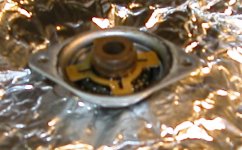 bearing_assy.jpg126.9 KB · Views: 191
bearing_assy.jpg126.9 KB · Views: 191 -
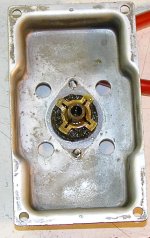 lower_bearing_assy.jpg208.7 KB · Views: 173
lower_bearing_assy.jpg208.7 KB · Views: 173 -
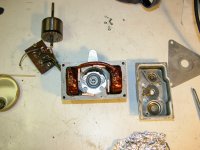 upper_housing_in_place.jpg198 KB · Views: 170
upper_housing_in_place.jpg198 KB · Views: 170 -
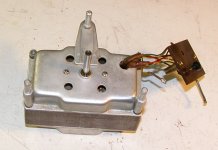 motor_together.jpg279.5 KB · Views: 176
motor_together.jpg279.5 KB · Views: 176 -
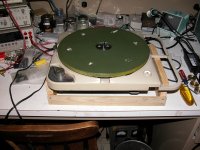 clarks_table_running.jpg203.1 KB · Views: 192
clarks_table_running.jpg203.1 KB · Views: 192 -
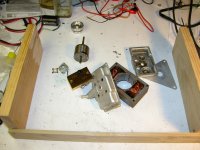 Motor all apart.jpg200.9 KB · Views: 190
Motor all apart.jpg200.9 KB · Views: 190
- Home
- Source & Line
- Analogue Source
- Restoring and Improving A Thorens TD-124 MKII
